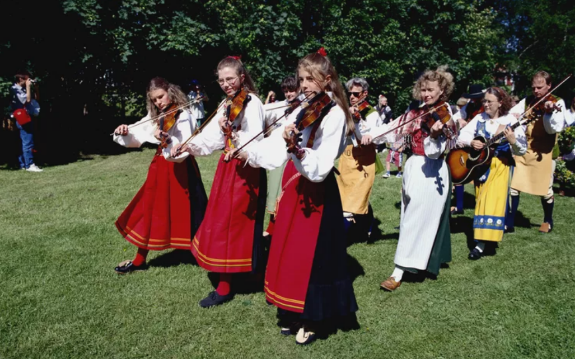
Have you ever heard any German folk songs? We invite you to listen to them, learn them, and yes, even sing them — even if your attempt is only in the shower. You’d be surprised at how rich the imagery can be in certain folk songs and how they offer a glimpse into German culture. It has been proven countless times that music can accelerate language learning, so why not take the plunge?
Der Mond ist Aufgegangen
This German folksong is extremely popular. It is sung by children, performed at church, and almost always heard when German folk songs are sung. It is a highly versatile song for teaching German. The first verse is best suited for beginners, while the other verses are more appropriate for intermediate students. Additionally, it is an excellent song for discussing symbolism and religion. This is a favorite folk song among teachers for introducing bird names — fourteen in total! Moreover, wedding vocabulary can be learned as the birds in the song celebrate a marriage.
Sah ein Knab ein Rӧslein stehn
This folk song serves as a good introduction to Goethe for advanced beginners. Written by Goethe in 1799, the poem “Heideröslein” has been set to music by multiple composers. The version sung today was composed by Schubert. A lesson on rhyme and symbolism can be presented through this song.
Im Frühtau zu Berge
Many Germans would be surprised to learn that this popular folk song originally hails from Sweden. It was translated into German in the early 20th century and immediately became a favorite “Wanderlied”, remaining so ever since. There have even been funny versions of this song, such as “Beim Frühstück am Morgen sie sehn” and “Im Frühstau bei Herne wir blühen richtig auf.”
Grün, Grün, Grün
Today, this is regarded more as a children’s song sung in primary grades. However, in the 19th century, it was known as a dancing folk song. This song is perfect for learning colors and job titles simultaneously. What I like most about this song is that you can insert your own color into the song, along with the accompanying job title associated with it.
原创编写 版权所有 侵权必究! 每日更新 个性化阅读 英语飙升!
2. 2. Why might “Sah ein Knab ein Rӧslein stehn” be used for advanced beginners?
A It focuses on basic color names.
B It introduces Goethe’s literary works.
C It contains humorous wedding scenes.
D It requires no knowledge of symbolism.
4. 4. What does “Grün, Grün, Grün” mainly focus on?
A Combining colors with jobs.
B Preserving Swedish traditions.
C Developing singing techniques.
D Documenting wedding customs.


 更多优质学习内容
更多优质学习内容

